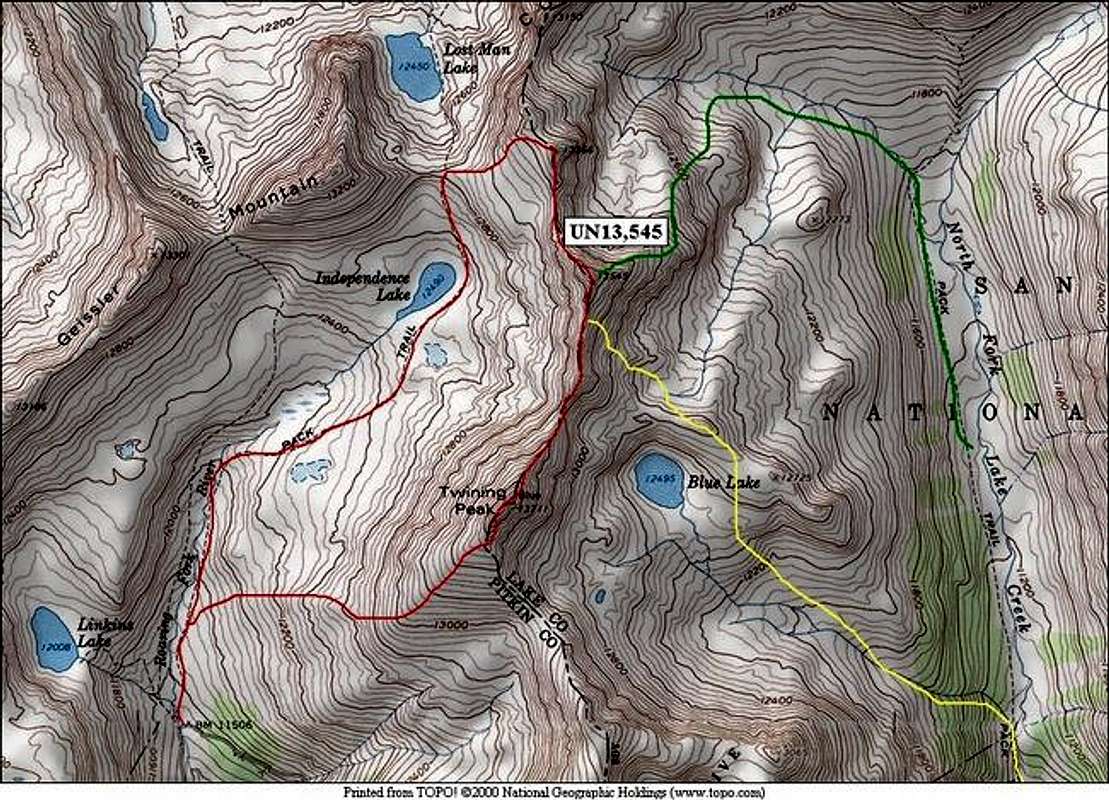|
|
Route |
|---|---|
|
|
39.14420°N / 106.5591°W |
|
|
scramble |
|
|
Most of a day |
|
|
class 4 |
|
|
Approach

North Ridge Route on UN13,545 and Twining Peak-RT-6 miles and 2,800-ft
The following is a logical and rewarding loop route, that requires a short approach to get to the goods. Escaping this long ridge that connects these two mountains is possible in some spots but not recommended due to the really loose nature of the rock. Almost every escape route would be down into the North Fork Lake Creek Drainage, away from your TH in the Independence Drainage. Only from the summit of Twining Peak is it possible to descend back down to the Independence Lake Drainage. Make sure you have good weather for this long ridge run.
Start at Linkins Lake TH at 11,520-ft and hike on a good trail 2.12 miles and 1,300-ft past Independence Lake to Lost Man Pass at 12,796-ft. Go east up easy tundra another 350-ft to the saddle between UN 13,366 and UN 13,545. The ridge immediately narrows and becomes class 3. From here the fun begins.
Route Description
Good route finding from here on out is essential. I’m lucky to have had ideal weather conditions that day because it allowed me to really take my time using my route finding skills. Having short-term goals on this ridge is a good idea. In the end, everything will work out.
From the saddle, locate the huge tower of rock way off on the highpoint of the ridge, your summit lies just a few feet beyond. Next, locate where the ridge suddenly jumps up and ascends past the huge tower of rock just before the summit, this is a good place to rest for the crux of your climb.
Begin the climb by ascending and traversing a series of loose rock towers and deep notches. Stay on the ridge crest when you can. When the crest of the ridge becomes too difficult, descend a bit to the east to bypass any obstacles. When bypassing these rock towers expect loose rock on slippery dirt. The ridge gets a little messy in some spots. Expect two easy class four spots that descend into and out of notches in the ridge. When the ridge finally begins its steep ascent past the huge rock tower, rest and begin a traverse east, across the really steep, slab ridden northeast face. Traverse around the rock tower and locate a weakness in the ledge-ridden slabs to gain back the ridge crest; this will be the toughest move of the day and it is exposed. Do a committing and exposed class 4 move on dirty slabs of granite and finally make the ridge crest again. Continue another 50 yards (class 2+) to the summit of UN 13,545.
The view of Twining Peak’s North Ridge Route from here is inspiring but looks difficult. I’m here to tell you that it goes and it’s on better footing than the section of north ridge of UN 13,545.
On to Twining Peak. Begin your descent down a steep grassy slope, the ridge will begin to narrow again as well as level out. Again, go out of your way to stay on the crest of this ridge, otherwise you will loose valuable vertical and before you know it you may be all the way down in the upper basin. The following section of ridge that descends to the saddle, includes a couple of nasty notches that can be down climbed on solid rock, expect easy class 4.
Once at the saddle, a huge wall of rock that looks too difficult to bypass on either side will welcome you. There is a notch up in there and locating it is key, for it delivers you right back up on Twining Peak’s north ridge. Climb the notch, expect tough class 3 or easy class 4 and gain the ridge crest, from here it is smooth sailing to Twining Peak’s summit.
From the summit is easy to locate the descent route back down into the Independence Lake Basin. There are a few variations to this descent route as well, so take you pick. The view of Grizzly Peak while descending back to the TH is inspiring as well.
Essential Gear
Good weather
Miscellaneous Info
If you have information about this route that doesn't pertain to any of the other sections, please add it here.

